Hendrik Borras
Variance-Aware Noisy Training: Hardening DNNs against Unstable Analog Computations
Mar 20, 2025


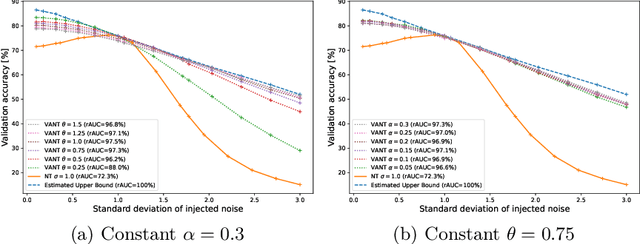
Abstract:The disparity between the computational demands of deep learning and the capabilities of compute hardware is expanding drastically. Although deep learning achieves remarkable performance in countless tasks, its escalating requirements for computational power and energy consumption surpass the sustainable limits of even specialized neural processing units, including the Apple Neural Engine and NVIDIA TensorCores. This challenge is intensified by the slowdown in CMOS scaling. Analog computing presents a promising alternative, offering substantial improvements in energy efficiency by directly manipulating physical quantities such as current, voltage, charge, or photons. However, it is inherently vulnerable to manufacturing variations, nonlinearities, and noise, leading to degraded prediction accuracy. One of the most effective techniques for enhancing robustness, Noisy Training, introduces noise during the training phase to reinforce the model against disturbances encountered during inference. Although highly effective, its performance degrades in real-world environments where noise characteristics fluctuate due to external factors such as temperature variations and temporal drift. This study underscores the necessity of Noisy Training while revealing its fundamental limitations in the presence of dynamic noise. To address these challenges, we propose Variance-Aware Noisy Training, a novel approach that mitigates performance degradation by incorporating noise schedules which emulate the evolving noise conditions encountered during inference. Our method substantially improves model robustness, without training overhead. We demonstrate a significant increase in robustness, from 72.3\% with conventional Noisy Training to 97.3\% with Variance-Aware Noisy Training on CIFAR-10 and from 38.5\% to 89.9\% on Tiny ImageNet.
On Hardening DNNs against Noisy Computations
Jan 24, 2025Abstract:The success of deep learning has sparked significant interest in designing computer hardware optimized for the high computational demands of neural network inference. As further miniaturization of digital CMOS processors becomes increasingly challenging, alternative computing paradigms, such as analog computing, are gaining consideration. Particularly for compute-intensive tasks such as matrix multiplication, analog computing presents a promising alternative due to its potential for significantly higher energy efficiency compared to conventional digital technology. However, analog computations are inherently noisy, which makes it challenging to maintain high accuracy on deep neural networks. This work investigates the effectiveness of training neural networks with quantization to increase the robustness against noise. Experimental results across various network architectures show that quantization-aware training with constant scaling factors enhances robustness. We compare these methods with noisy training, which incorporates a noise injection during training that mimics the noise encountered during inference. While both two methods increase tolerance against noise, noisy training emerges as the superior approach for achieving robust neural network performance, especially in complex neural architectures.
Walking Noise: Understanding Implications of Noisy Computations on Classification Tasks
Dec 20, 2022Abstract:Machine learning methods like neural networks are extremely successful and popular in a variety of applications, however, they come at substantial computational costs, accompanied by high energy demands. In contrast, hardware capabilities are limited and there is evidence that technology scaling is stuttering, therefore, new approaches to meet the performance demands of increasingly complex model architectures are required. As an unsafe optimization, noisy computations are more energy efficient, and given a fixed power budget also more time efficient. However, any kind of unsafe optimization requires counter measures to ensure functionally correct results. This work considers noisy computations in an abstract form, and gears to understand the implications of such noise on the accuracy of neural-network-based classifiers as an exemplary workload. We propose a methodology called "Walking Noise" that allows to assess the robustness of different layers of deep architectures by means of a so-called "midpoint noise level" metric. We then investigate the implications of additive and multiplicative noise for different classification tasks and model architectures, with and without batch normalization. While noisy training significantly increases robustness for both noise types, we observe a clear trend to increase weights and thus increase the signal-to-noise ratio for additive noise injection. For the multiplicative case, we find that some networks, with suitably simple tasks, automatically learn an internal binary representation, hence becoming extremely robust. Overall this work proposes a method to measure the layer-specific robustness and shares first insights on how networks learn to compensate injected noise, and thus, contributes to understand robustness against noisy computations.
Open-source FPGA-ML codesign for the MLPerf Tiny Benchmark
Jun 23, 2022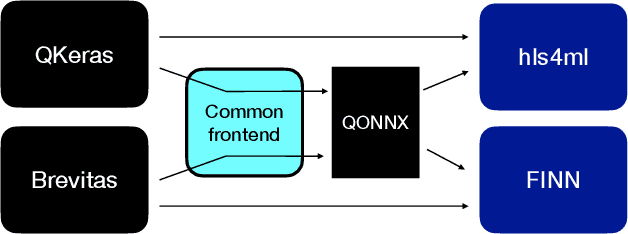

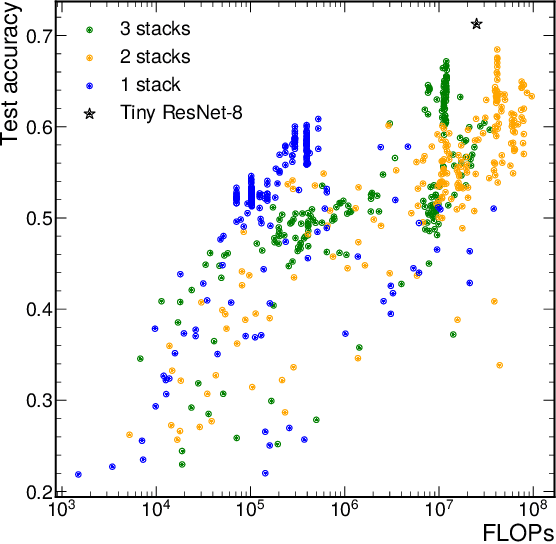

Abstract:We present our development experience and recent results for the MLPerf Tiny Inference Benchmark on field-programmable gate array (FPGA) platforms. We use the open-source hls4ml and FINN workflows, which aim to democratize AI-hardware codesign of optimized neural networks on FPGAs. We present the design and implementation process for the keyword spotting, anomaly detection, and image classification benchmark tasks. The resulting hardware implementations are quantized, configurable, spatial dataflow architectures tailored for speed and efficiency and introduce new generic optimizations and common workflows developed as a part of this work. The full workflow is presented from quantization-aware training to FPGA implementation. The solutions are deployed on system-on-chip (Pynq-Z2) and pure FPGA (Arty A7-100T) platforms. The resulting submissions achieve latencies as low as 20 $\mu$s and energy consumption as low as 30 $\mu$J per inference. We demonstrate how emerging ML benchmarks on heterogeneous hardware platforms can catalyze collaboration and the development of new techniques and more accessible tools.
QONNX: Representing Arbitrary-Precision Quantized Neural Networks
Jun 17, 2022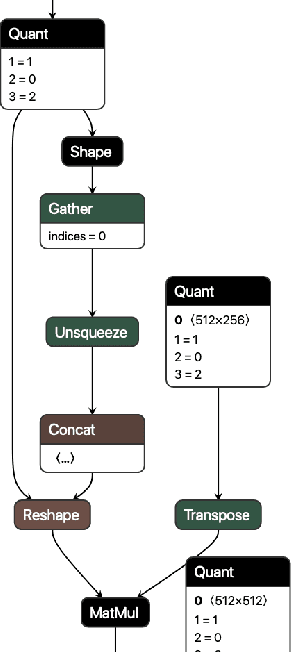
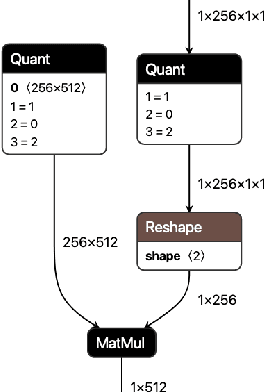
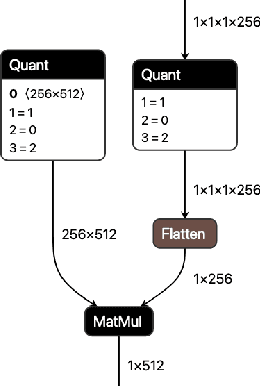
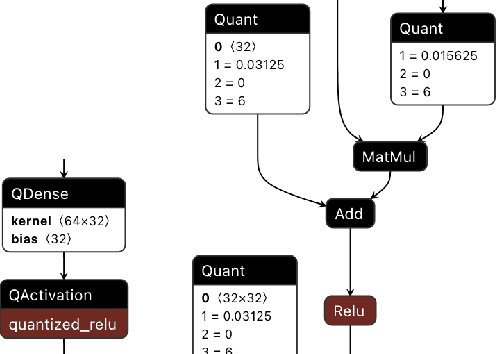
Abstract:We present extensions to the Open Neural Network Exchange (ONNX) intermediate representation format to represent arbitrary-precision quantized neural networks. We first introduce support for low precision quantization in existing ONNX-based quantization formats by leveraging integer clipping, resulting in two new backward-compatible variants: the quantized operator format with clipping and quantize-clip-dequantize (QCDQ) format. We then introduce a novel higher-level ONNX format called quantized ONNX (QONNX) that introduces three new operators -- Quant, BipolarQuant, and Trunc -- in order to represent uniform quantization. By keeping the QONNX IR high-level and flexible, we enable targeting a wider variety of platforms. We also present utilities for working with QONNX, as well as examples of its usage in the FINN and hls4ml toolchains. Finally, we introduce the QONNX model zoo to share low-precision quantized neural networks.
 Add to Chrome
Add to Chrome Add to Firefox
Add to Firefox Add to Edge
Add to Edge